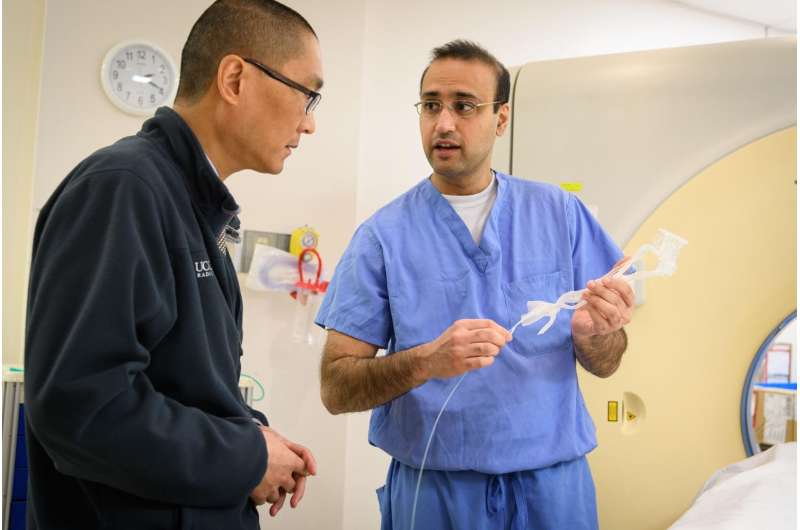New 3-D printed model allows brain surgeons to practice

The first time a young surgeon threads a wire through a stroke victim's chest up through their neck and fishes a blood clot out of their brain may be one of the most harrowing moments in her career. Now, a UConn Health radiologist and a medical physicist have made it easier for her to get some practice first. The team made a life-size model of the arteries that wire must pass through, using brain scans and a 3-D printer. They will make the pattern freely available to any doctor who requests it.
The Food and Drug Administration (FDA) approved mechanical thrombectomy - using a wire to pull clots out of the brains of stroke victims - in 2012. A trap at the end of the wire opens like a little snare that captures the clot, which is then dragged out of the patient.
A lot can go wrong on that journey. One of the most dangerous complications is also one of the most likely: another clot can be accidentally knocked loose from the wall of the arteries and get stuck in the heart, the lungs, or elsewhere in the brain. Computer simulations of the procedure exist, but they are prohibitively expensive for many medical schools to purchase. Interventional radiologists and neurosurgeons need to train extensively before they work on a real person.
UConn Health cardiac radiologist Dr. Clifford Yang and medical physicist intern David Brotman knew they could help young doctors feel more comfortable with the mechanics.
"What matters is the ability of the doctor to be confident in guiding the wire," says Brotman. He and Yang found a brain scan of a patient with typical blood vessel structure and used the scan to design a 3-D model of the blood vessels. Finding a good scan was easy: UConn Health has an immense library from computed tomography (CT) and magnetic resonance imaging (MRI) of patients. The tough part was converting the data into something a 3-D printer could interpret. Brotman and Yang found and modified publicly available software to do that, and after a couple months of tweaking, they found they could print a true-to-life teaching model of the brain's major arteries for about $14.
Technically called a brain perfusion phantom, the model is surprisingly delicate. Holding it in your hand brings home just how small the arteries are, even in an adult man. The top arch of the aorta in the chest, big enough to slide an adult's pinky finger through, connects to the carotid in the neck and then on to the Circle of Willis in the brain, which is no thicker than a fat piece of yarn. The circle has six branches. Each branch supplies blood to one-sixth of the brain. It is in these branches that clots are most likely to get stuck and cause serious damage.
"We are using this model to teach students," says UConn Health interventional radiologist Dr. Charan Singh. "Obviously, it won't feel like the human body. But it will improve their knowledge of anatomy, and give them basic technique on how to move the catheter."
Singh demonstrates how a slight twist can violently flip the catheter, which is dangerous. It could knock off new clots into the bloodstream. The model isn't perfect - there are several different ways a person's aorta can be shaped, and the other veins can vary too. But students can get good practice with it, Singh says.
Dr. Ketan Bulsara, UConn's chief of neurosurgery, also likes the technology. He cautions that individual anatomy varies too much for it to be used as the only training tool to learn mechanical thrombectomy, but says that it could potentially be used to visualize other conditions, such as brain tumors. Surgery for brain tumors has significant lead time, and modeling the tumor in advance could personalize and improve patient care.

















